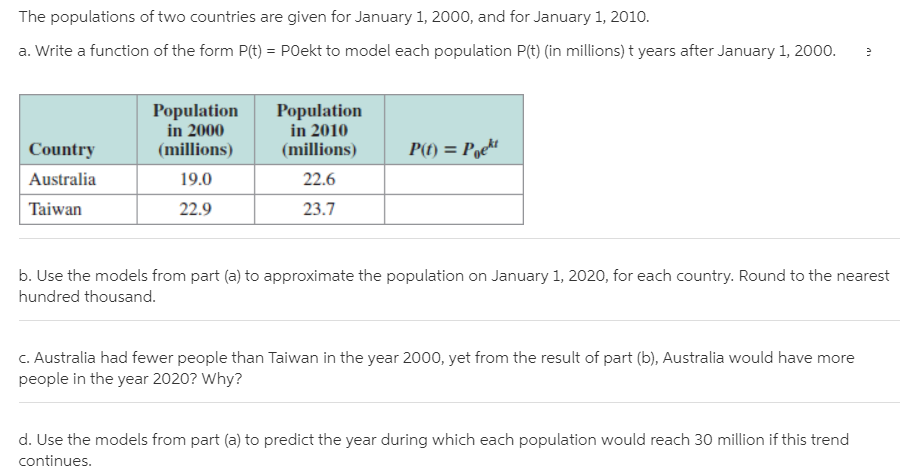The populations of two countries are given for January 1, 2000, and for January 1, 2010. a. Write a function of the form P(t) = POekt to model each population P(t) (in millions) t years after January 1, 2000. Population in 2000 (millions) Population in 2010 (millions) Country P(t) = Pgekt Australia 19.0 22.6 Taiwan 22.9 23.7 b. Use the models from part (a) to approximate the population on January 1, 2020, for each country. Round to the nearest hundred thousand. C. Australia had fewer people than Taiwan in the year 2000, yet from the result of part (b), Australia would have more people in the year 2020? Why? d. Use the models from part (a) to predict the year during which each population would reach 30 million if this trend continues.
The populations of two countries are given for January 1, 2000, and for January 1, 2010. a. Write a function of the form P(t) = POekt to model each population P(t) (in millions) t years after January 1, 2000. Population in 2000 (millions) Population in 2010 (millions) Country P(t) = Pgekt Australia 19.0 22.6 Taiwan 22.9 23.7 b. Use the models from part (a) to approximate the population on January 1, 2020, for each country. Round to the nearest hundred thousand. C. Australia had fewer people than Taiwan in the year 2000, yet from the result of part (b), Australia would have more people in the year 2020? Why? d. Use the models from part (a) to predict the year during which each population would reach 30 million if this trend continues.
Algebra & Trigonometry with Analytic Geometry
13th Edition
ISBN:9781133382119
Author:Swokowski
Publisher:Swokowski
Chapter7: Analytic Trigonometry
Section7.6: The Inverse Trigonometric Functions
Problem 91E
Related questions
Question

Transcribed Image Text:The populations of two countries are given for January 1, 2000, and for January 1, 2010.
a. Write a function of the form P(t) = POekt to model each population P(t) (in millions) t years after January 1, 2000.
Population
in 2000
(millions)
Population
in 2010
(millions)
Country
P(t) = Pgekt
Australia
19.0
22.6
Taiwan
22.9
23.7
b. Use the models from part (a) to approximate the population on January 1, 2020, for each country. Round to the nearest
hundred thousand.
C. Australia had fewer people than Taiwan in the year 2000, yet from the result of part (b), Australia would have more
people in the year 2020? Why?
d. Use the models from part (a) to predict the year during which each population would reach 30 million if this trend
continues.
Expert Solution
This question has been solved!
Explore an expertly crafted, step-by-step solution for a thorough understanding of key concepts.
This is a popular solution!
Trending now
This is a popular solution!
Step by step
Solved in 6 steps with 6 images

Recommended textbooks for you

Algebra & Trigonometry with Analytic Geometry
Algebra
ISBN:
9781133382119
Author:
Swokowski
Publisher:
Cengage

Functions and Change: A Modeling Approach to Coll…
Algebra
ISBN:
9781337111348
Author:
Bruce Crauder, Benny Evans, Alan Noell
Publisher:
Cengage Learning

College Algebra (MindTap Course List)
Algebra
ISBN:
9781305652231
Author:
R. David Gustafson, Jeff Hughes
Publisher:
Cengage Learning

Algebra & Trigonometry with Analytic Geometry
Algebra
ISBN:
9781133382119
Author:
Swokowski
Publisher:
Cengage

Functions and Change: A Modeling Approach to Coll…
Algebra
ISBN:
9781337111348
Author:
Bruce Crauder, Benny Evans, Alan Noell
Publisher:
Cengage Learning

College Algebra (MindTap Course List)
Algebra
ISBN:
9781305652231
Author:
R. David Gustafson, Jeff Hughes
Publisher:
Cengage Learning

Glencoe Algebra 1, Student Edition, 9780079039897…
Algebra
ISBN:
9780079039897
Author:
Carter
Publisher:
McGraw Hill

Algebra and Trigonometry (MindTap Course List)
Algebra
ISBN:
9781305071742
Author:
James Stewart, Lothar Redlin, Saleem Watson
Publisher:
Cengage Learning

College Algebra
Algebra
ISBN:
9781305115545
Author:
James Stewart, Lothar Redlin, Saleem Watson
Publisher:
Cengage Learning